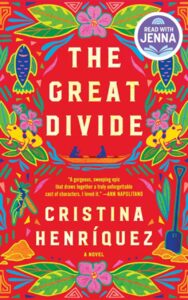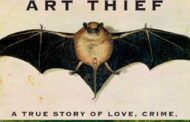Book Short
‘The Great Divide’
by Cristina Henriquez
Reviews by Stephanie Miller

In an epic tale amid the backdrop of the building of the Panama Canal, we are treated to exquisite prose and the interconnected stories of overworked laborers, a merciless foreman, despairing fishermen, earnest hometown advocates, and young entrepreneurs.
Many Panamanians thought the US-led canal project in the early 1900s was delusional. Hadn’t previous attempts by other nations failed? In “The Great Divide” by Cristina Henriquez, a local fisherman reflects:
“The spine of the Cordillera Mountains, running straight through the isthmus, stood in the way after all, and of the many miraculous things Francisco has heard in his life, he had never heard of a ship that could sail through a mountain. So they would cut the mountains, they said, and break the spine and once that was done, the water from both oceans would gush forth from each end and join to create a way through. Who could believe such a thing?”
Omar goes off to help dig the canal
Francisco’s son Omar believes it. And so, despite his father’s anger at his capitulation to the American capitalists, goes off to help dig the canal. The work is brutal, but he finds community there. Overworked, he collapses on the street and is saved by Ada, a teenager from Barbados. Ada is desperate to earn money for an operation that will save her sister’s life. In her typical rashness and devotion to justice, she pulls Omar from a crowd of onlookers frozen by fear of contagion, puts him on a train, and bribes the conductor to take him to the hospital.
Ada and the regional director’s wife
That act of compassion gets Ada a job tending another patient, none other than the wife of the American regional director. She becomes the only one who actually sees Marian Oswald as a person. Their genuine friendship is a powerful counterpoint to the strict class distinctions enforced in the zone, which made it hard for any local or laborer to thrive.
Although they paid for the narrow strip of land that became the canal zone, the Americans did little for the local economy, bringing in strange foods, paying low wages, not bothering to learn Spanish, and taxing Panamanian goods.
One of the most poignant examples of the caste system is when Director Oswald rides by “the cut” where the canal is being dug:
“Omar stood in the mud with his pick and a strange feeling came over him. In the midst of the work, the men had all stopped what they were doing and stood to the side. It was just that, nothing more. They stood to the side. Here in the country where Omar had been born and had lived every day of his life, a man had arrived, and Omar stood to the side.”
Another day, his ambitious and cruel foreman tells Omar:
“I came to this country to help you make something out of it, see? No one in their right mind wanted to set foot here before, […] But now everyone wants to be here. […] you people had this place to yourselves for hundreds of years and managed to make it a swamp. But we got rid of yellow fever and built bridges and towns. We paved your streets and gave you water that runs through pipes underground. That’s civilization, see? […] We gave you a gift. You’re supposed to say thank you when someone gives you a gift!”
Amid this backdrop of economic inequity, there is patriotism, hope, and even love. Although we don’t learn a lot about the engineering or politics of the canal, we do get to meet the kind of people who built it… and were displaced by it.
Micro Shorts
“Daughters of Shandong”
by Eve J. Chung
When the communist revolution upended the landowner-tenant system in China after World War 2, many prominent Nationalists followed Chiang Kai Shek to Taiwan. Left behind were the wife and three daughters of the first son of the wealthy Ang family in Shandong. The reason was ostensibly to “watch the house.” But truly, the reason was much darker. The daughters were of no value and wives who didn’t produce sons were unworthy of love and support.
Based on the true story of Chung’s grandmother, this is a powerful, fast moving story of resilience and the indomitable warrior-girl spirit. It follows an epic journey of torture, starvation, and escape. All fueled by a mother’s courage in the face of impossible odds. The looming question? Will their husband/father take them back, or was the revolution a convenient reason to abandon these worthless females? The mother-daughter and sister relationships are very well drawn, and make the harrowing journey all the more believable and touching. A great snowy day read that I found on the featured tables at our amazing Portland Public Library.
“The Bell in the Lake”
by Lars Mytting
This is the first of a magical realism trilogy of early 20th Century rural Norway emerging from the grip of old myths and the farming people’s laconic acceptance of deadly, harsh winters in overpopulated remote towns isolated from and resistant to modernization.
Astrid Hekne is my kind of heroine: plucky, smart, industrious, creative, and passionate. She first falls for the local priest, but their tremulous courting is interrupted by the priest’s own modernization scheme. He will sell the historic, crumbling stave church to the royalty of Dresden. Then he will use the cash to build a larger building. One that can be properly heated and meet the needs of the growing population.
The enormous and uniquely sonorous “sister bells” were placed in the belfry by Astrid’s ancestors. It was an extravagant act of remembrance that impoverished her family. Reputed to ring on their own accord, the bells are wrapped in legend and mystery. Astrid vows to save them from the German buyers – and in doing so sets in motion a swirl of love, intrigue, outright theft, and tragedy.
The grief throughout this novel is just about unbearable, but there are fabulous moments of happiness in between. This novel has it all — love, suspense, betrayal, nature, architectural history, and superstition — set in spectacular surroundings. Bonus: I was introduced to stave churches, which have a fascinating history.
“By Any Other Name”
by Jodi Picoult
I love a good Shakespeare conspiracy, and Picoult presents hers in a complex narrative weave of two oppressed women. One a 16th Century courtesan who is literally the property of men with no public opportunities to express her storytelling talent. The other a modern aspiring playwright who limits her own success through relentless self-defeatism. Helping the two narratives along are quotes from the many clever, fierce, proto-feminist characters in the Shakespeare canon: Portia, Beatrice, Rosalind, and Viola, among others.
The idea is that Shakespeare was more like an agent. He was presenting under his own name the works of a group of playwrights who for various reasons needed to stay anonymous. One of them was the real-life Emilia Bassano who was the first woman to publish a book of poetry in England.
This novel raises an intriguing question. Could a character like Juliet or Lady MacBeth or the “shrew” Katherine ever be written by a man of that time?





